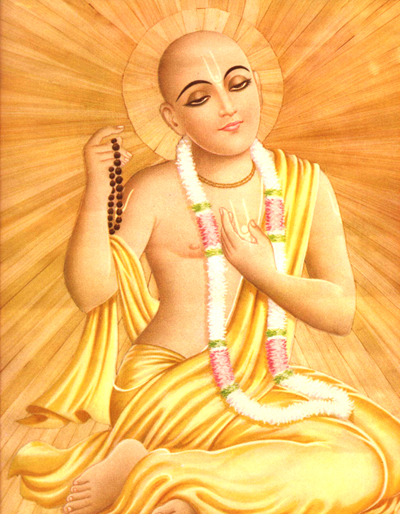Chaitanya Mahaprabhu (18 February 1486 – 14 June 1534) was a spiritual leader who founded Gaudiya Vaishnavism. He is believed by his devotees to be Krishna himself who appeared in the form of His own devotee in order to teach the people of this world the process of Bhakti and how to attain the perfection in life. He is considered as the most merciful manifestation of Krishna. Chaitanya was the proponent for the Vaishnava school of Bhakti yoga (meaning loving devotion to God), based on Bhagavata Purana and Bhagavad Gita. Of various incarnations of Vishnu, he is revered as Krishna, popularised the chanting of the Hare Krishna mantraand composed the Siksastakam (eight devotional prayers) in Sanskrit. His followers, Gaudiya Vaishnavas, revere him as a Krishna with the mood and complexion of his source of inspiration Radha.
Chaitanya is sometimes referred to by the names Gauranga or Gaura due to his fair complexion, and Nimai due to his being born underneath a Neem tree. There is no evidence, however, that he was born under a Neem Tree. He was very mischievous in his young days. His original name was Vishvambhar. He was a brilliant student and Nimai was his nickname. At an early age he became a scholar and opened a school.
Chaitanya means living force, Maha means Great and Prabhu means ‘Lord’ or ‘Master’ Chaitanya Mahaprabhu is the Supreme Personality of Godhead, Sri Krishna himself. He was born as the second son of Jagannath Mishra and his wife Sachi Devi, who lived in the town of Dhaka Dakhhin, Srihatta, now Sylhet, Bangladesh. According to Chaitanya Charitamruta, Chaitanya was born on the full moon night of 18 February 1486, at the time of a lunar eclipse. His parents named him ‘Vishvambhara’. His family roots are originally from Dhaka Dakhhin, Sylhet Shrihatta (now Sylhet, Bangladesh),
A number of stories also exist telling of Chaitanya’s apparent attraction to the chanting and singing of Krishna’s names from a very young age, but largely this was perceived as being secondary to his interest in acquiring knowledge and studying Sanskrit. When travelling to Gaya to perform the shraddha ceremony for his departed father, Chaitanya met his guru, the ascetic Ishvara Puri, from whom he received initiation with the Gopala Krishna mantra. This meeting was to mark a significant change in Chaitanya’s outlook and upon his return to Bengal the local Vaishnavas, headed by Advaita Acharya, were stunned at his external sudden ‘change of heart’ (from ‘scholar’ to ‘devotee’) and soon Chaitanya became the eminent leader of their Vaishnava group within Nadia.
After leaving Bengal and receiving entrance into the sannyasa order by Keshava Bharati, Chaitanya journeyed throughout the length and breadth of India for several years, chanting the divine Names of Krishna constantly. He spent the last 24 years of his life in Puri, Odisha, the great temple city of Jagannath in the Radhakanta Math. The Gajapati king, Prataparudra Dev, regarded Chaitanya as Krishna’s avatar and was an enthusiastic patron and devotee of Chaitanya’s sankeertan gatherings. It was during these years that Chaitanya is believed by his followers to have sunk deep into various Divine-Love (samādhi) and performed pastimes of divine ecstasy (bhakti).
Chaitanya’s influence on the cultural legacy in Bengal and Odisha has been significant, with many residents performing daily worship to him as an avatar of Krishna. Some attribute to him a Renaissance in Bengal,different from the more well known 19th-century Bengal Renaissance. Salimullah Khan (b. 1958), a noted Bangladeshi linguist, maintains, “Sixteenth century is the time of Chaitanya Dev, and it is the beginning of Modernism in Bengal. The concept of ‘humanity’ that came into fruition is contemporaneous with that of Europe”.
Noted Bengali biographical film on Chaitanya, Nilachaley Mahaprabhu (1957), was directed by Kartik Chattopadhyay (1912-1989).
(Ref: https://en.wikipedia.org/wiki/Chaitanya_Mahaprabhu & harekrsna.de)
